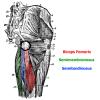Folders |
Hamstring Dysfunction and Running
Published by
Hamstring pain and tightness is a common complaint in the running world, as such, today I hope to shed a little bit of insight into the chronic hamstring dysfunction. If your hamstring is acutely injured and swelling, pain, and bruising are present, then what I am about to say is not going to be the best idea. In such a scenario, you’d surely benefit from some rest and a few visits with a skilled sports medicine professional. That said, if you are able to run without much undue strain or pain occurs with higher intensity running or longer duration, a program built to restore neural input and optimize function of the gluteus maximus may be a good idea. A recently published study in the Journal of Orthopaedic and Sports Physical Therapy demonstrated that in athletes experiencing exercise induced hamstring cramping benefit greatly from such a protocol. Approaching the idea of hamstring strains from a perspective considering synergistic dominance, a re-education program focused on the gluteal complex also makes sense. Sahrmann’s synergistic dominance concept essentially says that when muscles designed to execute a particular motion produce lower force or exert poor control, muscles that share some of the same functions will kick on to pick up the slack. In the case of the hamstrings, such a muscle or better yet, group of muscles, that lose ability to fire optimally are the “glutes.” To compensate for a lack of hip extension by the powerful glues, the hamstrings and often the adductor magnus (the fourth hamstring) kick into overdrive. After a period of time with this strategy, the muscles reach their tissue tolerance threshold and “pulls” and “strains” come into the picture. As such, restoring or optimizing gluteal function may offer some benefits for hamstring strains and or fatigue. Additionally, you’ll probably see some benefits as they relate to body angles while running (the glutes serve to keep your torso erect) and even more powerful, efficient striding. In the study referenced above, they authors utilized a three phase approach over the course of six months. It appears as follows: Phase 1: Isolated Activation Exercises Within the first phase they taught the subject how to properly activate his gluteals using a variety of lower level, activation type exercises including clam shells, hip extensions, and “fire hydrant” exercises in quadruped. Attention was taken to reduce the load and proper execution of exercise was monitored. This phase lasted about four weeks. Phase 2: Weight bearing exercises Once satisfied with the first phase, the athlete was prescribed dynamic weight bearing exercises including dynamic side squats, star balance drills, step downs, and forward and reverse lunges. This phase lasted until week 16. Phase 3: Functional Training In this phase the athlete was advanced to functional activities that included plyometic activities (both double and single support) to train in eccentric activity of the gluteals as they are to decelerate the swing leg in flexion before producing extension. Over time, the subject reported no complaints of cramping. If you have a troubled hamstring, it may be a wise idea to address it from the point of synergistic dominance. Best regards,
|




